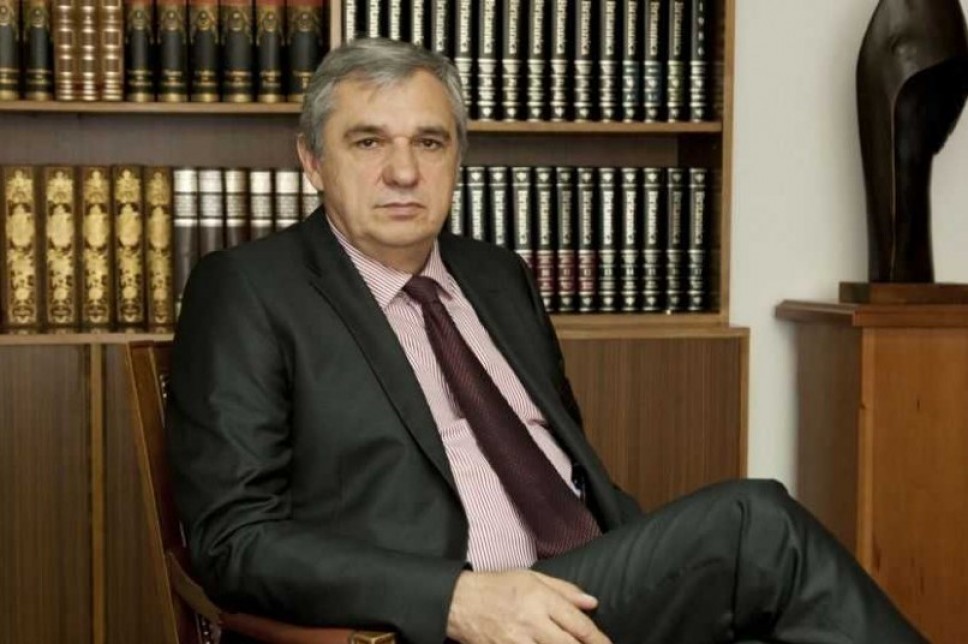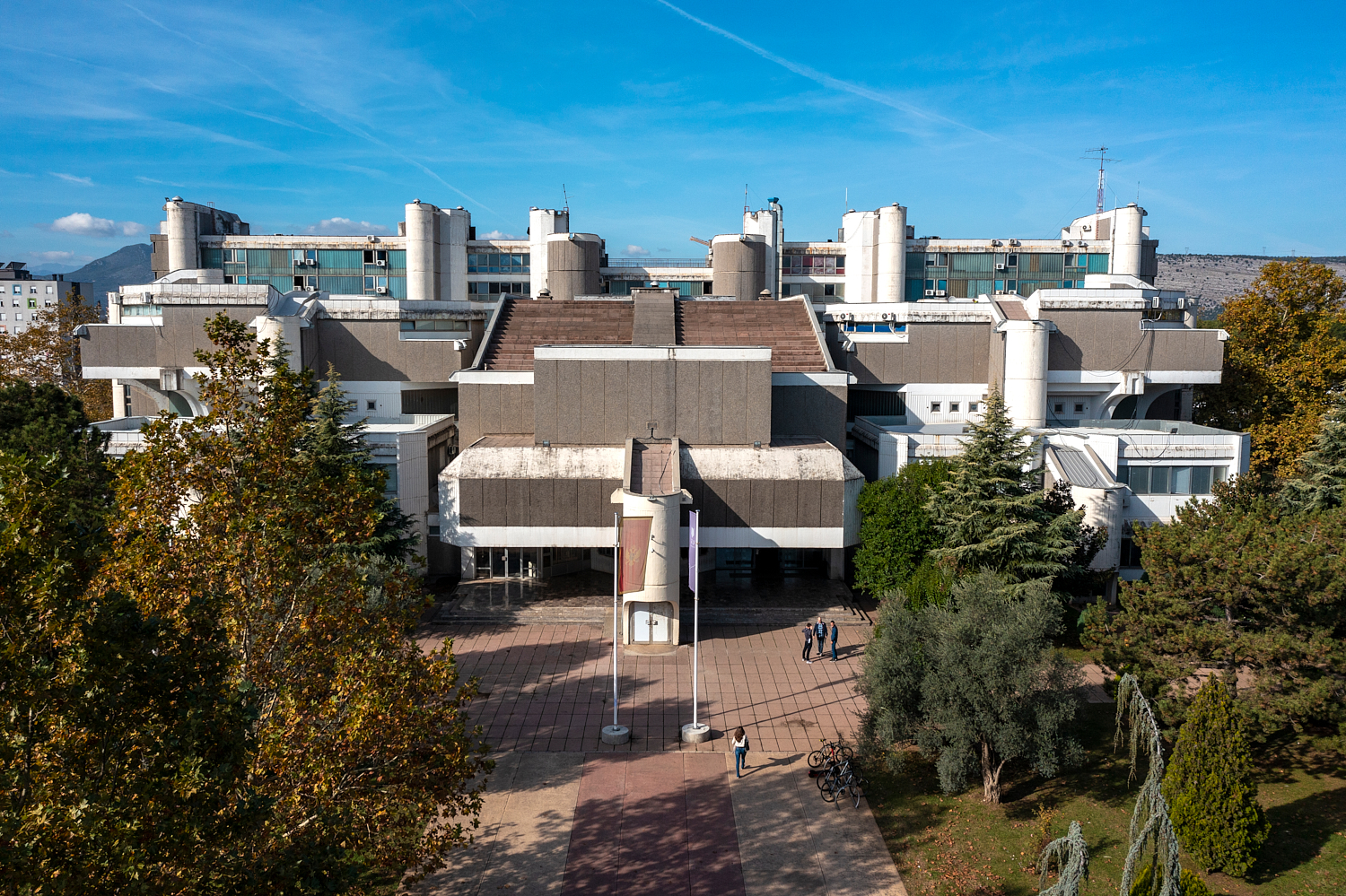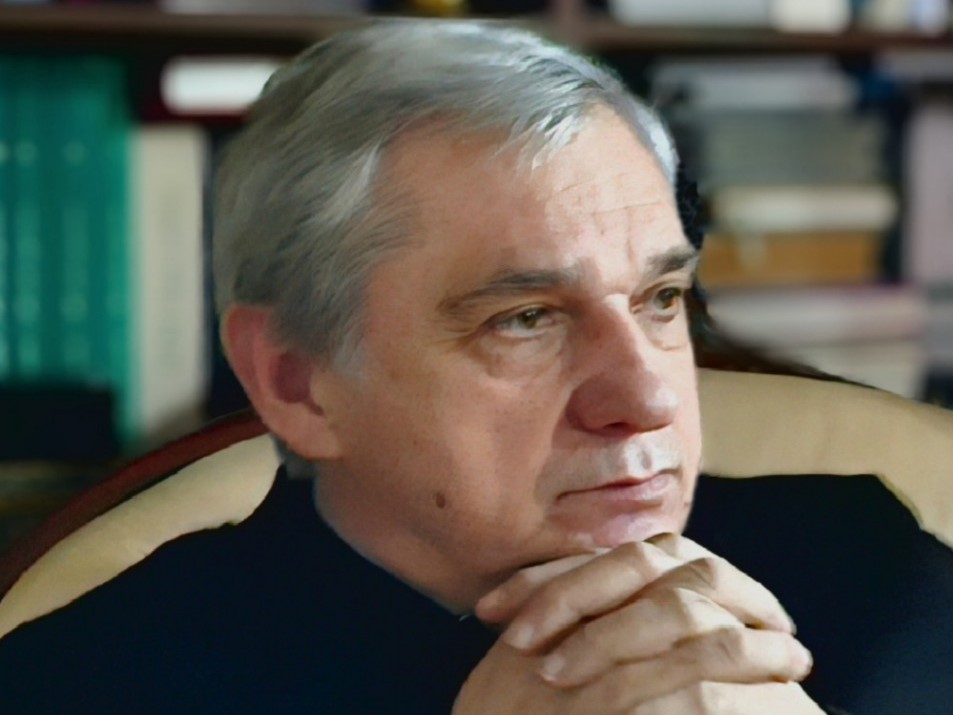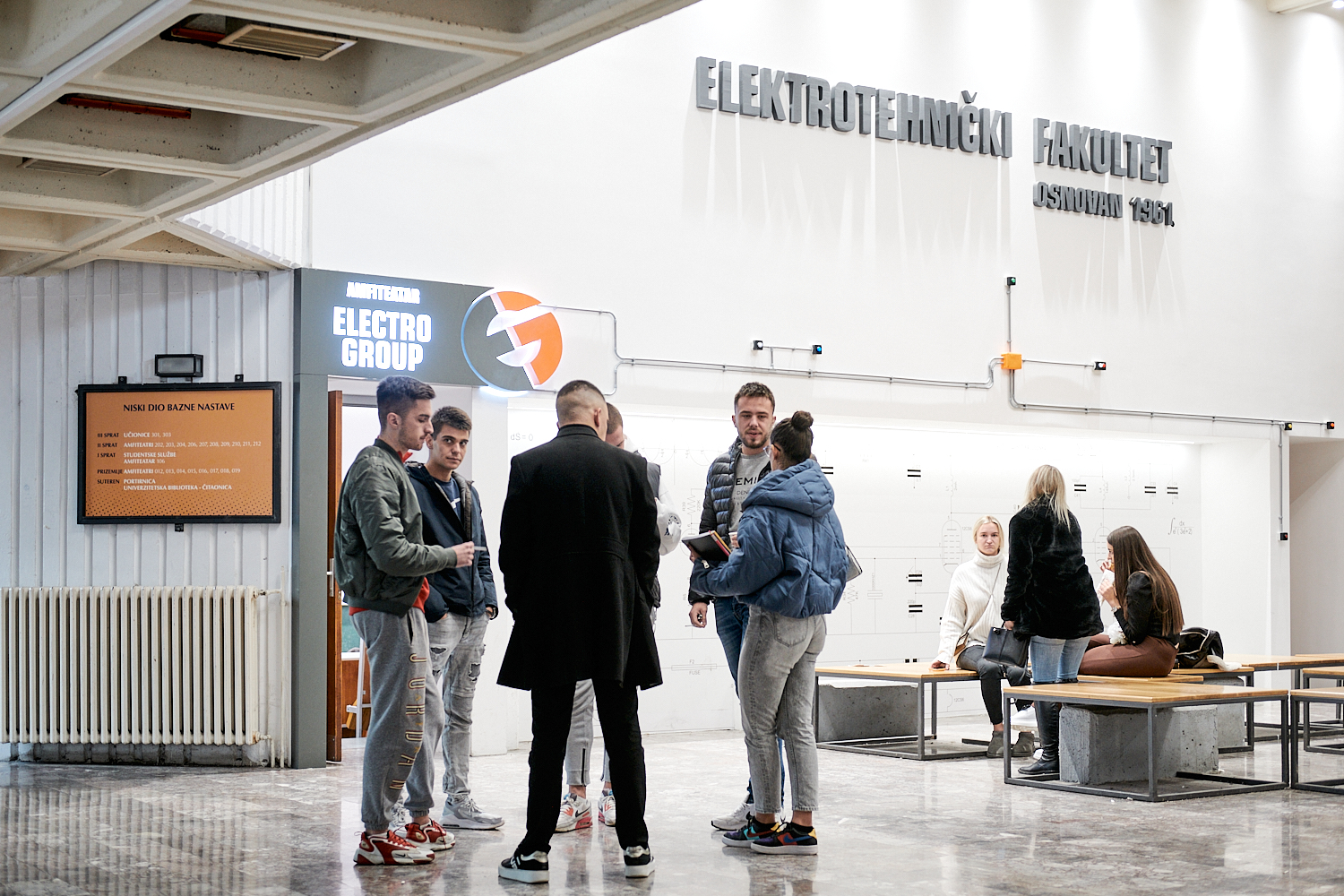Stanković: Univerzitet Crne Gore kao kuća mudrosti i znanja

Velika snaga i katalizator napretka Univerziteta Crne Gore u njegovih 50 godina svakako su, između ostalog, bili uspješni studenti koji su zahvalnost za svo stečeno znanje i iskustvo pokazali tako što su svoje karijere posvetili UCG-u i godinama ostali uz njega u formi profesora ili saradnika. Na ovaj način su sve stečene vrijednosti odlučili da prenesu na nove generacije, te da otklone prepreke sa kojima su se susretali kada su i sami bili studenti.
Ovakvoj plemenitoj misiji posvetio se i dr Ljubiša Stanković, najbolji diplomirani student za 1982. godinu, iste godine proglašen i za najboljeg studenta u Crnoj Gori, a danas redovni profesor na Elektrotehničkom fakultetu.
Od diplomiranja 1982. godine radi na Elektrotehničkom fakultetu Univerziteta Crne Gore. U zvanje redovnog profesora izabran je 1995. godine. U dva mandata bio je rektor Univerziteta Crne Gore (2003–2005. i 2005–2008. godine).
U susret 50. rođendanu Univerziteta prof. Stanković se prisjetio svog usavršavanja, svih prekretnica i izuzetnih ličnih uspjeha koji su čvrsto isprepletani sa razvojem UCG-a. Upoznajući nas sa svojim životopisom, on inspiriše mlade generacije da iskoriste sve potencijale koje Univerzitet pruža, poziva ih da ostanu u Crnoj Gori i budu dio promjene koju žele da vide u društvu.
Kakvu je ulogu u Vašem životu i usavršavanju odigrao Univerzitet Crne Gore? Koliko Vas je inspirisao i usmjerio za dalje ciljeve?
PROF. DR STANKOVIĆ: Moj život i razvoj visokog obrazovanja i Univerziteta Crne Gore su i simbolički veoma isprepletani. Rođen sam u Murini, iste godine kada je osnovana prva visokoškolska ustanova u Crnoj Gori, a samo godinu kasnije u Crnoj Gori počinju i studije elektrotehnike, koje će obilježiti moj životni i stvaralački put. I dok se visoko obrazovanje razvija, institucionalno jača i oblasti visokog obrazovanja, ja završavam osnovnu školu u Murini i Beranama, gdje upisujem i gimnaziju, tačno u godini kada se osniva današnji Univerzitet Crne Gore. Tokom narednog četvorogodišnjeg perioda, dok sam učio gimnaziju, izgrađena je zgrada tehničkih fakulteta, simbol Univerziteta Crne Gore i njegovo dugogodišnje sjedište. Nakon upisa na Elektrotehnički fakultet 1978. godine, moja generacija je kasnila sa početkom redovne nastave, čekalo se da se dobije upotrebna dozvola za korištenje zgrade. Tako smo, te godine, sa tim malim zakašnjenjem počeli sa prvim predavanjima u novoj zgradi, simbolu i današnjeg Univerziteta.
Susret sa fakultetom je bio pun strahopoštovanja, strepnje da možda neću uspjeti, jer se to već desilo mnogim mojim poznanicima i prijateljima koji su bili odlični i talentovani učenici. Oni su, takođe, imali ogromnu želju da završe taj, po težini, poznati fakultet i postanu vrsni inženjeri i stručnjaci. Na prva predavanja, kolokvijume i ispite sam dolazio sa velikim poštovanjem prema profesorima i saradnicima u toj kući mudrosti i znanja. Predavali su nam ne samo profesori iz Crne Gore, već i sa čitavog prostora bivše Jugoslavije, posebno sa Univerziteta u Beogradu. Prve desetke na ispitima su mi ulile više samopouzdanja. Bio sam na drugoj godini studija kada sam osvojio prvo mjesto na takmičenju iz matematike, na kome su učestvovali studenti iz cijele tadašnje Jugoslavije. To takmičenje je bilo vrlo značajno za prestiž i ugled fakulteta. Prvo mjesto je pokazalo da znanje koje stičem na našem fakultetu, ne samo da se može mjeriti sa većim i starijim fakultetima, već čak i biti ispred njih. To je bio i dokaz kvaliteta studija na tada jednom od najmlađih univerziteta u Jugoslaviji. Kasnije su se ređale desetke i još jedno osvajanje prvog mjesta iz matematike, a onda i završetak tadašnjih četvorogodišnjih studija za 3 godine i devet mjeseci, sa samo jednom devetkom i brojnim društvenim priznanjima i nagradama. Igrom sudbine ta devetka je bila upravo iz predmeta gdje sam dva puta bio prvi u Jugoslaviji, što dodatno pokazuje težinu i karakter tadašnjih studija.
Rezultati koje sam ostvario na fakultetu bili su osnova da donesem odluku da svoj život posvetim univerzitetskoj karijeri i Univerzitetu Crne Gore. Ipak, prije nego što se potpuno posvetim radu u Crnoj Gori, želio sam uporediti svoje znanje i proširiti vidike u drugim sredinama. Magistrirao sam na Univerzitetu u Beogradu, a onda odmah nakon toga, kao dobitnik Fulbrajtove stipendije, boravio jednu studijsku godinu na univerzitetu u Sjedinjenim Američkim Državama u državi Masačusets. Nakon što sam položio sve ispite na doktorskim studijama i dobio ugovor da sa 24 godine radim kao predavač na tom univerzitetu, ipak sam se vratio u Crnu Goru i tu nastavio nastavni i istraživački rad. Na Univerzitetu Crne Gore sam doktorirao 1988. godine u oblasti elektromagnetnih talasa i u pripremi doktorata objavio prve naučne radove u vodećim časopisima.
Nakon doktorata odlučujem da se posvetim oblasti digitalne obrade signala i problemima digitalizacije u najširem smislu, oblasti koju sam izučavao tokom boravka u SAD. Odluka da se posvetim istraživanju u toj oblasti, a onda i predajem digitalnu obradu signala je došla još te davne 1984. godine, prije tačno 40 godina, kada je sva elektrotehnika bila zasnovana na analognim uređajima (sjećate se onih velikih širokih televizora). Tada se moglo teško i uz puno mašte, naslućivati da će računari i informacione tehnologije, zasnovani na digitalizaciji, igrati iole značajniju ulogu u našim životima. U takvim okolnostima, na uvođenje predmeta digitalna obrada signala na osnovne studije se gledalo i kao na neki ustupak od strane kolega, jer se ta forma digitalizacije tada na ovim našim prostorima nigdje nije izučavala na osnovnim studijama. U to vrijeme radim i na prvim knjigama iz digitalne obrade signala i primjene MATLAB-a, koje su štampane krajem osamdesetih, po prvi put na nekom od južnoslovenskih jezika. Time počinje i moja puna posvećenost naučnim istraživanjima u oblasti digitalne obrade signala.
I tako od prije 40 godina do danas. A digitalizacija, od fikcije u nauci u međuvremenu postaje stvarnost, a sada i dio svakodnevnog života, pa čak postoji potreba i za odvikavanjem od digitalnih servisa pojedinih segmenata društva. Počinje era vještačke inteligencije zasnovane na fundamentima digitalizacije i informacionih tehnologija.
Tih mojih 40 godina predavanja, stalnog usavršavanja, razvoja istraživačke grupe, su isključivo vezani za Univerzitet Crne Gore, bez obzira na kraće ili duže boravke na Univerzitetu u Bohumu u Njemačkoj, Tehničkom univerzitetu u Ajndhovenu u Holandiji, univerzitetima u Brestu i u Grenoblu u Francuskoj, Imperijal Koledžu u Velikoj Britaniji. Ponosan sam na brojne saradnike, od kojih su pojedini prošli nivo od početnih istraživačkih koraka do najviših univerzitetskih i akademskih titula i priznanja. Zahvaljujući tom zajedničkom radu, imamo danas situaciju da je i po oblasti digitalne obrade signala Univerzitet Crne Gore prepoznat na istraživačkoj mapi svijeta. Imamo nekoliko urednika vodećih naučnih časopisa u svijetu, preko 300 radova članova grupe u vodećim časopisima, nekoliko godišnjih nagrada za najbolji rad objavljen u vodećim časopisima na svijetu, najviša zvanja u profesionalnim udruženjima, kao i izuzetnu citiranost, sa ukupnim brojem od preko 25.000 citata članova istraživačkog tima u ovoj oblasti. Zahvaljujući toj citiranosti tri profesora Univerziteta Crne Gore iz oblasti obrade signala, koji već dugi niz godina imaju samostalne istraživačke pravce, nalaze se među dva odsto najcitiranijih naučnika u svijetu Stanfordove liste citiranosti (od njenog osnivanja do danas), što bi bio veliki uspjeh za jednu oblast i na vodećim univerzitetima svijeta. Zadovoljstvo mi je da sam i sam, gotovo u potpunosti ostvarujući svoju naučnu karijeru na Univerzitetu Crne Gore, među 0.1 odsto najcitiranijih naučnika u oblasti informaciono-komunikacionih tehnologija i da je prosječna citiranost radova u oblasti obrade signala objavljenih od strane autora iz Crne Gore prema Journal Citation Reports (JCR), najveća u regionu Istočne Evrope, a to znači ispred Rusije, Češke, Slovenije, Poljske, Ukrajine, Mađarske, Estonije... Na rang listi čitavog svijeta, po kriterijumu prosječne citiranosti radova u oblasti obrade signala (kao jednom od temeljnih stubova digitalizacije i vještačke inteligencije), Crna Gora zahvaljujući radovima sa Univerziteta Crne Gore zauzima visoko mjesto, ispred zemalja tehnoloških giganata, kao što su Njemačka, Italija, Francuska, Španija, Norveška, Južna Koreja, Meksiko, Brazil, Kina, Argentina, Turska…
Univerzitet ste imali prilike da upoznate kao jedan od najboljih studenata Elektrotehničkog fakulteta, kao profesor na istom i kao rektor UCG u dva mandata. Kako Vam se percepcija mijenjala i kako ste svoje iskustvo uložili u napredak UCG?
PROF. DR STANKOVIĆ: U vrijeme kad sam ja studirao i neposredno nakon toga na Elektrotehničkom fakultetu je dominirao kadar formiran tokom osnivanja fakulteta i Univerziteta, uz brojnu pomoć vodećih profesora iz ondašnje Jugoslavije, posebno Beograda. Bila je to generacija čija je misija bila uspostavljanje temelja visokog obrazovanja u Crnoj Gori, od presudne uloge za društvenu emancipaciju, kulturni i ekonomski razvoj ovog prostora. Zbog toga se moramo uvijek prisjetiti sa velikim poštovanjem i odnositi sa uvažavanjem prema tim doajenima elektrotehnike i Univerziteta u Crnoj Gori. Pošto su studije već bile utemeljene, mojoj generaciji je pripala istorijska dužnost da pokuša napraviti ovaj Univerzitet prepoznatljivim na međunarodnoj sceni, kao svojim naučnim radom tako i reformama visokog obrazovanja koje će ga učiniti dijelom evropskog i svjetskog sistema visokog obrazovanja.
Do promjene generacija u rukovođenju Univerzitetom dolazi 2003. godine kada sam izabran za rektora. Prije mene je bilo sedam rektora i lijepa činjenica je bila da su u tom trenutku svih sedam prvih rektora bili živi. Ja sam, čini mi se, bio prvi na poziciji rektora koji je i svoje osnovno univerzitetsko obrazovanje stekao na Univerzitetu Crne Gore. Imao sam i posebno zadovoljstvo da skoro svim prethodnim rektorima i lično uručim tada ustanovljenu povelju zaslužnog profesora emeritusa. Nakon toga se nastavlja tradicija da Univerzitetom upravljaju rektori čija je alma mater Univerzitet Crne Gore ili, što bi slobodno preveli, rektori od te 2003. godine do danas su "djeca Univerziteta Crne Gore".
Izuzetno mi je zadovoljstvo i čast da sam u jednom periodu obavljao funkciju rektora Univerziteta Crne Gore, djelimično se odričući vremena koje je trebalo biti posvećeno naučnim istraživanjima. U tom periodu, od 2003. do 2008. godine, urađeno je dosta toga kada je u pitanju reformama Univerziteta. Reformisan je nastavni proces i usaglašen sa evropskim standardom koji je predstavljala Bolonjska deklaracija. Reforma je tada veoma pažljivo urađena, uz inovativni pristup, tako da novi sistem bude potpuno usklađen i sa traženim okvirom kvalifikacija u Crnoj Gori. Napisan je i usvojen set ključnih normativnih akata, počev od Zakona i Statuta do brojnih pravilnika kojima je uređen sistem visokog obrazovanja na Univerzitetu Crne Gore, a što je objavljeno u knjizi Dokumenti 2004, poznatoj kao Plava knjiga. Dosta toga što je objavljeno u toj knjizi je predstavljalo temelj za dalji rad ne samo Univerziteta Crne Gore nego i privatnih visokoškolskih ustanova koje su se osnivale u narednom periodu. Odrađena je digitalizacija nastavnog procesa i rezultata studiranja, što nam je omogućilo da već 2005. godine imamo digitalnu bazu i mogućnost pregleda opterećenja nastavnika i uspjeha studenata u realnom vremenu, odmah nakon završetka semestara. Počelo se i sa nagrađivanjem rezultata naučnog rada što je nastavljeno i do danas. Tada je postojao fond koji je omogućavao svim zaposlenim da kraći dio vremena u toku godine provedu na nekom od univerziteta u svijetu sa ciljem uspostavljanja saradnje i širenja vidika u nastavnom i naučnom radu. U tom periodu su svi zaposleni koji su imali potrebu za rješavanjem ili unapređenjem uslova stanovanja riješili svoj problem, bilo putem stanova ili kredita, a zadovoljstvo mi je bilo da sam bio u prilici da predam novom rukovodstvu nekoliko stanova za koje nije bilo više zainteresovanih u tom periodu, kao i značajan ostatak neutrošenih sredstava od nekoliko miliona na računu Univerziteta i bez ikakvih kreditnih obaveza. Sve je to urađeno samofinasiranjem i održivim investicionim planom bez dodatnih sredstava u budžetu i bez ikakvih kredita. Na kraju mi je posebno drago da smo 2008. godine uradili prvi dio Univerzitetskog parka, koji se kasnije širio i danas predstavlja pravi dragulj i ponos našeg Univerziteta, Glavnog grada i Crne Gore.
Osim naukom, bavili ste se i umjetničkom fotografijom. Koliko je značajno da se mladi, ali i svi drugi ljudi usavršavaju na više polja i uz cjeloživotno učenje istraže sve strane svoje ličnosti?
PROF. DR STANKOVIĆ: Fotografijom sam se počeo baviti i prije nego što sam i pomišljao da će elektrotehnika odrediti moj životni put. Počeo sam još od foto sekcije u osnovnoj školi, da bih tokom i pri kraju srednje škole više vremena provodio u foto laboratoriji nego u učenju svih predmeta zajedno, uključujući i matematiku. Radio sam puno fotografija na dnevnom nivou, što stičući svoje redovne prihode još od 16. godine života, što izrađujući umjetničke fotografije. Tokom posljednje godine srednje škole stižu i prva veoma visoka priznanja, kao što su prva nagrada na godišnjoj republičkoj izložbi umjetničke fotografije i druga nagrada na foto konkursu Pobjede za 1978. godinu, uz tada već brojnija učešća na izložbama širom Jugoslavije. Odmah nakon upisa na Elektrotehnički fakultet pokrenuo sam inicijativu i bio jedan od osnivača Foto kluba Student na Univerzitetu Crne Gore. Tu smo od osnivanja održavali brojne foto kurseve i obučavali, mogu slobodno reći, hiljade mladih, prije svega studenata. Upoznavali smo ih sa tajnama fotografije, tokom više od desetak godina aktivnog rada Kluba. Organizovane su brojne izložbe na nivou Univerziteta Crne Gore, ali i zapažene izložbe na nivou Jugoslavije u saradnji sa kolegama iz gradskog Foto kluba Titograd. I u tom periodu su se nizale brojne nagrade za fotografiju, a za najveći uspjeh smatram to da je Foto klub Student 1986. godine sa svojom kolekcijom ušao u 20 najboljih klubova bivše Jugoslavije, a moja fotografija te godine bila ocijenjena kao peta fotografija na najprestižnijoj izložbi u zemlji, dvogodišnjem Kupu jugoslovenske fotografije. Kasnije se ipak moj životni put okreće u pravcu naučnih istraživanja, na kratko i ka politici gdje sam bio član Predsjedništva Crne Gore i kao predsjednik Reformskih snaga Jugoslavije za Crnu Goru bio kandidat za predsjednika Crne Gore na prvim višestranačkim izborima. Međutim, biti u samom vrhu u dvije ili više oblasti nije ni malo jednostavno i ja sam u periodu koji je slijedio, nakon početka devedesetih godina prošlog vijeka, gotovo prestao da se bavim umjetničkom fotografijom, a ubrzo potom i politikom, i posvetio se Univerzitetu i nauci.
Izuzeteno je važno da mladi pored studija budu i društveno angažovani, da imaju svoj hobi i svestrana kulturna, umjetnička, sportska i socijalna interesovanja. Međutim, veoma je teško postizati vrhunske rezultate u više oblasti, tako da se u principu uvijek mora razdvojiti profesionalnost od hobija i posebna pažnja poklanjati onom osnovnom životnom opredjeljenju. A fokus se tokom života mijenja. Intersantno je reći da, na primjer u SAD, ljudi po nekoliko puta u životu promijene oblast svog profesionalnog angažovanja i to se često opredjeljujući za veoma različite oblasti.
Kakva je bila dosadašnja saradnja UCG i CANU? Gdje bi se mogla učvrstiti ova saradnja i kakve zajedničke projekte priželjkujete za budućnost?
PROF. DR STANKOVIĆ: Odnos ove dvije institucije je veoma specifičan. Većina od 39 sadašnjih članova CANU je svoj radni vijek provela ili provodi na Univerzitetu Crne Gore. Tako je bilo i u prošlosti. I pošto CANU nema svojih istraživačkih instituta i saradnika u istraživanju, akademici se i danas u dobrom dijelu za svoja istraživanja oslanjaju na infrastrukturu i saradnike, uglavnom sa Univerziteta Crne Gore, naravno odnedavno i na kapacitete drugih univerziteta u Crnoj Gori. CANU prije svega igra posebnu, zakonom definisanu ulogu, najviše naučne ustanove u Crnoj Gori, čiji je cilj, između ostalog, i objedinjavanje naučnih, umjetničkih i istraživačkih kapaciteta u našoj državi. Sa Univerzitetom Crne Gore, kao institucijom od posebnog interesa i značaja, je potpisan i ugovor o bilateralnoj saradnji i formiran tim za planiranje i praćenje zajedničkih aktivnosti. Održan je jedan broj manifestacija u zajedničkoj organizaciji, ali je ta saradnja takva da je u svim aktivnostima CANU, projektima, tribinama, okruglim stolovima, leksikonima, Enciklopediji Crne Gore, učešće nastavnika i saradnika sa Univerziteta Crne Gore od ključne važnosti za njihovu uspješnu realizaciju. Siguran sam da će ubuduće biti mogućnosti i za tješnju projektnu saradnju, posebno prilikom apliciranja i realizacije brojnih i široko-otvorenih mogućnosti kod fondova Evropske unije, a na dobro svih u Crnoj Gori.
Šta biste poručili Univerzitetu za njegov 50. rođendan? Kakve savjete za budućnost biste dali?
PROF. DR STANKOVIĆ: Uloga Univerziteta Crne Gore je umnogome posebna. To je sada jedini državni univerzitet u Crnoj Gori, a do nedavno je bio i jedina visokoškolska institucija. U tom smislu, Univerzitet Crne Gore ima veliku društvenu odgovornost. Mora osigurati svim građanima Crne Gore mogućnost ispunjenja želje da stiču visoko obrazovanje i da permanentno uče i šire svoja znanja. A potreba za tim je izuzetna, jer uslovi u kojima živimo, radimo i stvaramo se mijenjaju gotovo iz dana u dan i treba prihvatati sve novine i biti spreman za ono što tek dolazi. Zbog toga smatram da je obaveza Univerziteta Crne Gore da svim mladima koji žele da stiču visoko obrazovanje u Crnoj Gori to i obezbijedi. To je i poseban društveni imperativ jer Crna Gora nema priliv mladih obrazovanih ljudi sa strane. Svakog mladog čovjeka koji želi da stiče visoko obrazovanje, a kome ne obezbijedimo tu mogućnost u Crnoj Gori, on će to potražiti u okruženju ili dalje u inostranstvu. Poslije nekoliko godina studiranja, ti mladi se ukorjenjuju u nove sredine i većina njih ostaje da svoj radni, stvaralački i porodični život provodi u tim sredinama. Zaista mi je teško kada vidim da neko od izvanrednih i talentovanih mladih ljudi ne uspije da se upiše na željeni fakultet u Crnoj Gori, zbog nekih naših neracionalnih i vještačkih limita, zbog toga ode, bude među najboljima na prijemnom na mnogo većim i univerzitetima sa dužom tradicijom u okruženju, tamo bude jedan od najboljih studenata i naravno prihvati neku od brojnih ponuda da nastavi rad u toj sredini, a Crnu Goru nastavi posjećivati preko ljeta dok su mu roditelji živi. Univerzitet Crne Gore mora da da šansu svim mladima koji žele da ostanu u Crnoj Gori, koji žele da studiraju ovdje, žele da budu tu i pokušaju, u skladu sa svojim znanjem i sposobnostima, ostvariti svoje životne ciljeve. Mi ih ne smijemo odbiti prilikom upisa i tako bukvalno otjerati iz Crne Gore. Za mnoge studijske programe nema alternative u Crnoj Gori. Ostajanje ispod crte prilikom upisa na Univerzitetu Crne Gore često znači i zatvaranje vrata za ostanak u Crnoj Gori i trajni odlazak i gubitak najdragocjenijeg, ljudskog, potencijala naše zemlje.
Naravno jedan broj mladih će odlaziti, čak i ako omogućimo sve uslove u Crnoj Gori. Zbog toga Univerzitet Crne Gore ima i posebnu društvenu misiju da obezbijedi atraktivnost svojih studijskih programa i ulova studiranja da jedan broj mladih iz okruženja i čitavog svijeta dođe i studira kod nas. Tako se mora obezbijediti uravnotežena i veoma poželjna razmjena znanja i ljudi, ali bez gubitka ukupnog broja. A srećne su one sredine u koje se više dolazi radi studiranja i rada nego što se iz njih odlazi. To mora da nam bude cilj, a Univerzitet Crne Gore je glavna karika u ostvarenju tog cilja. Umjesto što su se ponekada davale stipendije da naši mladi odlaze i napuštaju Crnu Goru, mnogi od njih zahvaljujući tim našim stipendijama i trajno ostanu, sada moramo okrenuti proces i stipendirati ljude iz okruženja i svijeta da dođu kod nas i ovdje studiraju. Neki će onda trajno ostati i povećavati stvaralački potencijal Crne Gore, a neki će biti do kraja života ambasadori Crne Gore u svojim sredinama, nakon povratka.
Da bi obezbijedio i kvalitetno obrazovanje za potrebe našeg društva i države, kao i da bi mogao privući studente sa strane, Univerzitet Crne Gore mora imati najširu lepezu obrazovnih profila i školovati kadrove za gotovo sve profile. Mi nemamo mogućnost da se usresredimo na one programe koji su najatraktivniji i ostavimo niz važnih oblasti bez mogućnosti obrazovanja. U tom smislu Univerzitet Crne Gore i pruža veliku raznovrsnost studijskih programa, ali na širenju lepeze se mora i dalje raditi.
Uporedo sa najširim spektrom studijskih programa, u jednom dijelu oblasti se mora postići izvrsnost na najvišem nivou. Dio odabranih programa se mora uzdići iznad visokoobrazovne nastavne funkcije i ostvarivati naučne rezultate na nivou vodećih univerziteta u svijetu. Taj proces se mora podsticati i od strane države i od strane rukovodstva Univerziteta. Samo tako ćemo opravdati svoju univerzitetsku misiju, misiju naučne ustanove koja na rezultatima vrhunskog naučnog i umjetničkog rada stvara uslove za obrazovanje mladih koji će biti nosioci razvoja Crne Gore i šire.

